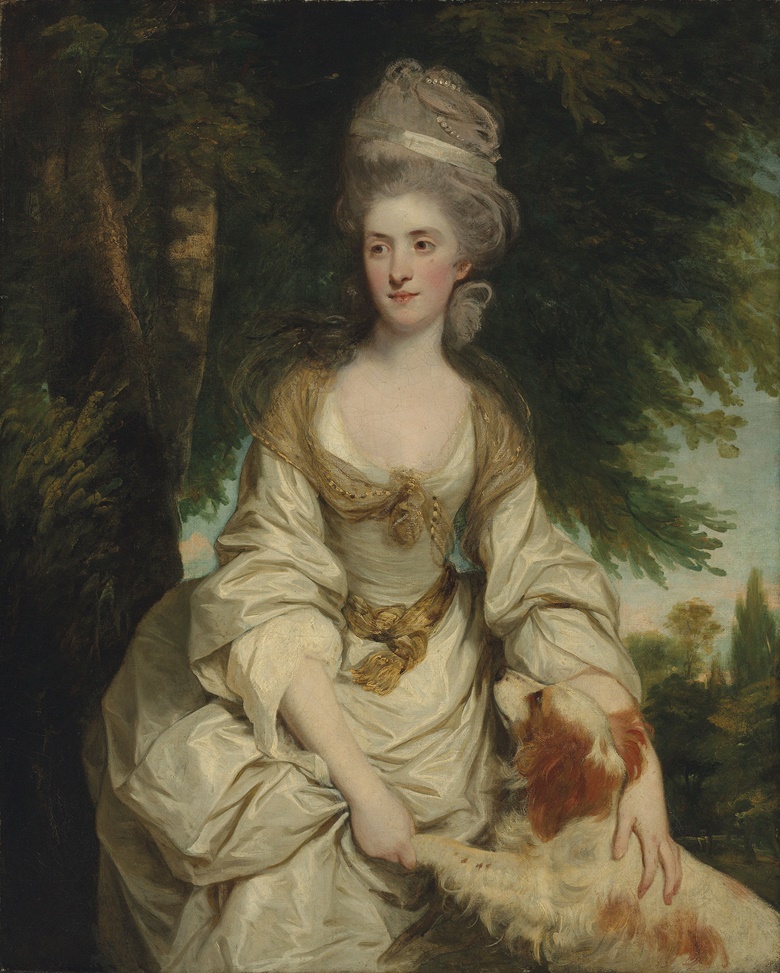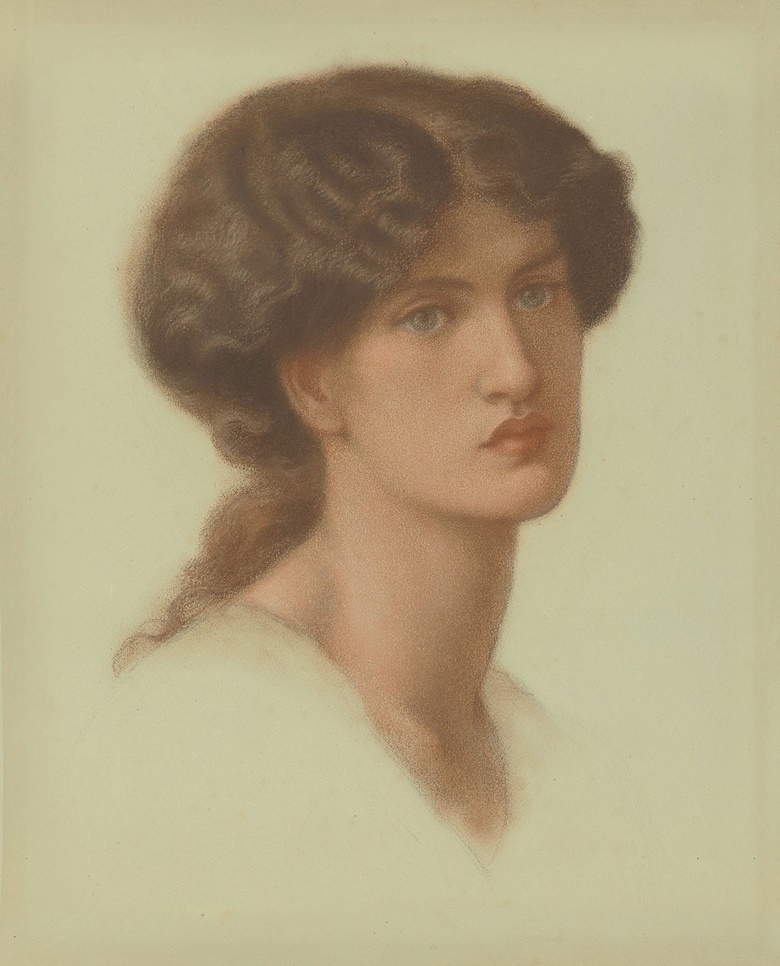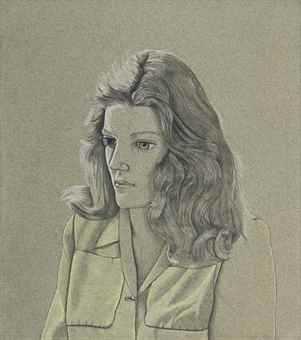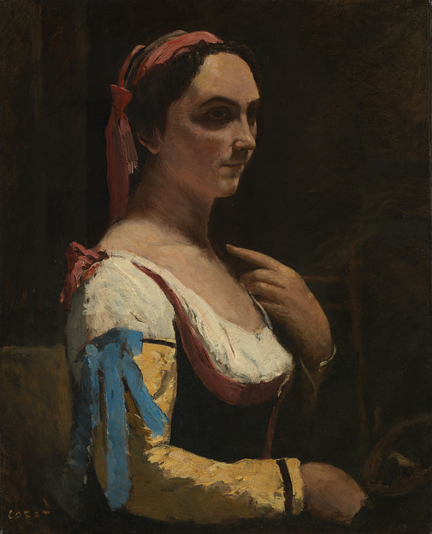The
National Gallery, London
23 June – 4 September 2016
This
summer, the National Gallery explores great paintings from a unique
perspective: from the point of view of the artists who owned them.
Spanning over five hundred years of art history,
Painters’ Paintings
presents more than eighty works, which were once in the possession of
great painters: pictures that artists were given or chose to acquire,
works they lived with and were inspired by. This is an exceptional
opportunity to glimpse inside the private world of these painters and to
understand the motivations of artists as collectors of paintings.
Jean-Baptiste-Camille Corot, ‘Italian Woman,
or Woman with Yellow Sleeve (L'Italienne)', about 1870 © The National
Gallery, London
The inspiration for this exhibition is a painter’s painting: Corot’s
Italian Woman,
left to the nation by Lucian Freud following his death in 2011. Freud
had bought the 'Italian Woman' 10 years earlier, no doubt drawn to its
solid brushwork and intense physical presence. A major work in its own
right, the painting demands to be considered in the light of Freud’s
achievements, as a painter who tackled the representation of the human
figure with vigour comparable to Corot’s.
In his will, Freud stated that he wanted to leave the painting to the
nation as a thank you for welcoming his family so warmly when they
arrived in the UK as refugees fleeing the Nazis. He also stipulated that
the painting’s new home should be the National Gallery, where it could
be enjoyed by future generations.
Anne Robbins, Curator of 'Painters’ Paintings' says:
“Since its acquisition the painting’s notable provenance has
attracted considerable attention – in fact the picture is often
appraised in the light of Freud’s own achievements, almost eclipsing the
intrinsic merits of Corot’s canvas. It made us start considering
questions such as which paintings do artists choose to hang on their own
walls? How do the works of art they have in their homes and studios
influence their personal creative journeys? What can we learn about
painters from their collection of paintings? 'Painters’ Paintings: From
Freud to Van Dyck' is the result.”
The National Gallery holds a number of important paintings which,
like the Corot, once belonged to celebrated painters: Van Dyck’s Titian;
Reynolds’s Rembrandt, and Matisse’s Degas among many others. 'Painters’
Paintings' is organised as a series of case studies each devoted to a
particular painter-collector: Freud,
Matisse,
Degas,
Leighton,
Watts,
Lawrence,
Reynolds, and
Van Dyck.
'Painters’ Paintings' explores the motivations of these artists – as
patrons, rivals, speculators - to collect paintings. The exhibition
looks at the significance of these works of art for the painters who
owned them - as tokens of friendship, status symbols, models to emulate,
cherished possessions, financial investments or sources of inspiration.
Works from these artists’ collections are juxtaposed with a number of
their own paintings, highlighting the connections between their own
creative production and the art they lived with. These pairings and
confrontations shed new light on both the paintings and the creative
process of the painters who owned them, creating a dynamic and original
dialogue between possession and painterly creation.
Half the works in the exhibition are loans from public and private
collections, from New York and Philadelphia to Copenhagen and Paris. A
number of them have not been seen in public for several decades.
Dr Gabriele Finaldi, Director of the National Gallery says:
“Artists by definition live with their own pictures, but what
motivates them to possess works by other painters, be they
contemporaries – friends or rivals – or older masters? The exhibition
looks for the answers in the collecting of Freud, Matisse, Degas,
Leighton, Watts, Lawrence, Reynolds, and Van Dyck.”
Lucian Freud (1922–2011)
Lucian Freud’s work remains at the forefront of British figurative
art. Fascinated by the tactile quality of paint, Freud had a lifelong
fascination with the great painters of the past, and often visited
museums and galleries, “I go and see pictures rather like going to the
doctor. To get some help”, he said. At home, Freud surrounded himself
with works of art he could admire in the flesh: paintings by 19th
century French and British masters -
Constable,
Corot, Degas – each exuding their own unique energy.
This room includes
examples of these, such as Corot’s 'Italian Woman' (about 1870, The
National Gallery, London), displayed here just as Freud showed it in his
drawing room: between a small Degas bronze ('Portrait of a Woman',
after 1918, Leeds Museums and Galleries (Leeds Art Gallery)), and a
sketch sent to him by his friend Frank Auerbach as a birthday card
(2002, Fitzwilliam Museum, University of Cambridge).
Freud’s attachment for the paintings he owned – here,
L’Après-Midi à Naples
Paul Cézanne
1876-1877
© Photo courtesy of the owner
a rarely seen
Cézanne brothel scene ('Afternoon in Naples', 1876–77, Private
Collection)
Portrait of Laura Moubray
John Constable
1808
© National Galleries of Scotland
and delightful Constable portrait ('Laura Moubray', 1808,
Scottish National Gallery, Edinburgh) – is explored in his section,
which also looks at the influence of these works on his own
investigations into the human figure.
The exhibition features Freud’s
own striking 'Self Portrait: Reflection' (2002, Private Collection)
and a
nude portrait, 'After Breakfast' (2001, Private Collection).
Henri Matisse (1869–1954)
Matisse started acquiring pictures long before he had encountered
success and could afford to do so; his collection also grew through
gifts and exchanges with fellow artists. He famously swapped pictures
with Picasso: he sent the Spanish artist a drawing in 1941 as a thank
you for Picasso looking after his bank vault in occupied Paris.
Picasso responded with the majestic, spectacularly sombre
Portrait of a Woman: Dora Maar
Pablo Picasso
20 January 1942 Private collection, United Kingdom
© Photo courtesy of the owner/Christie's, London © Succession Picasso/DACS London 2016
'Portrait
of Dora Maar' (1942, Courtesy The Elkon Gallery, New York), sent to
Matisse as a get-well present, after decades of a complicated friendship
tinged with rivalry.
La Maison verte, Venise
Paul Signac
1905 Private collection
© Photo © Christie's Images / Bridgeman
A fine Signac ('The Green House', Venice, 1905,
Private Collection) illustrates Matisse’s practice to swap works of art
with painter friends,
Three Bathers
Paul Cézanne
1879-1882
Petit Palais, Musée des Beaux-Arts de la Ville de Paris
© Petit Palais / Roger-Viollet
while an iconic work by
Cézanne,
'Three Bathers' (1879–82, Petit Palais, Musée des Beaux-Arts de la
Ville de Paris) shows how the pictures Matisse owned served his own art
directly.
Having bought it in 1899 – then a great financial sacrifice – Matisse
kept it for 37 years, during which, he said, he “came to know it fairly
well, though [he] hoped, not entirely”. This painting
Young Man with a Flower behind his Ear
Paul Gauguin
1891
Property from a distinguished Private Collection,© Photo © Christie's Images / Bridgeman Images
and his
Gauguin
'Young Man with a Flower behind his Ear' (1891, Property from a
distinguished Private Collection - courtesy of Christie's) informed
Matisse’s own bold, simplified style, as his work was evolving towards a
greater degree of abstraction, evident in his spectacular sculpture
'Back III' (1916–17, Centre Pompidou, Mnam/Cci, Paris), borrowing from
his Cézanne.
Combing the Hair ('La Coiffure')
Hilaire Germain Edgar Degas
about 1896
© The National Gallery, London
We know tantalisingly little about the circumstances
surrounding Matisse’s purchase of Degas’s
Combing the Hair
(about 1896, The National Gallery, London) yet the painting can be
viewed from the vantage point of Matisse’s own work, rich in such scenes
– as reflected in his 'The Inattentive Reader' (1919, Tate).
Hilaire-Germain-Edgar Degas (1834–1917)
A supreme master of technique and unrivalled experimentalist, Degas
was an astute observer of modern life, yet his art remained embedded in
tradition. He was also one of the greatest collectors of his time.
“Degas carries on…buying, buying: in the evening he asks himself how he
will pay for what he bought that day, and the next morning he starts
again…” a friend wrote in 1896. Degas often traded his own paintings or
pastels against the pieces he coveted most (Manet, 'Woman with a Cat',
1880–2, Tate). He acquired a wide range of works, from Old Masters
paintings to pictures by artists considered, at that time, avant-garde,
such as Cézanne’s' Bather with Outstretched Arm' (1883–85, Collection
Jasper Johns).
Degas collected the work of Manet, doggedly tracking down the dispersed sections of
The Execution of Maximilian
(about 1867–8,
©The National Gallery, London) after the death of his
friend.
He purchased great numbers of works of art by his heroes Ingres
(
Oedipus and the Sphinx, about 1826,
and
Angelica saved by Ruggiero, 1819–39, both National Gallery, London)
and
Delacroix ('Hercules
rescuing Hesione', 1852, Ordrupgaard, Copenhagen and
'Study of the Sky
at Sunset', 1849–50, The British Museum, London), focussing his
attention on paintings which held a particular emotional significance
for him and collecting those works as an act of homage. He also
supported struggling artists – Gauguin,
Sisley
- by buying their works
(Sisley, 'The Flood. Banks of the Seine', Bougival, 1873, Ordrupgaard, Copenhagen), providing them with
much-needed financial support.
Frederic, Lord Leighton (1830–1896) and George Frederic Watts (1817–1904)
One of the most renowned painters and sculptors of the Victorian era,
and the leading figure of its art establishment, Leighton was aware of
the power of art to convey social prestige and guarantee professional
progress. He displayed in his sumptuous Holland Park studio-house the
magnificent ensemble of pictures and objects he had purchased. Among
them were
Italian Renaissance paintings which showed his refined taste (Possibly by Jacopo Tintoretto,
Jupiter and Semele, about 1545, The National Gallery, London) but also mid-19th century. French landscapes alluding to his continental training.
Corot’s
Four Times of Day
(about 1858, The National Gallery, London) formed the centrepiece of
his drawing room, an enlightened choice showing Leighton’s advanced
appreciation of French landscape painters. There, the Corot panels
served as a source of inspiration as much as interior decoration,
resonating with Leighton’s own landscapes, arguably the most individual
part of his artistic production ('Aynhoe Park', 1860s, and 'Trees at
Cliveden', 1880s, both Private Collection).
The painter George Frederic Watts, Leighton’s friend, neighbour, and
regular visitor to his house, would have been impressed by the vast
array of pictures in Leighton’s collection. The two artists shared a
love for Italy and a desire to belong to the great artistic tradition
reaching back to the Renaissance; in his 'Self Portrait in a Red Robe'
(about 1853, Watts Gallery) he depicted himself in the robes of a
Venetian senator. Determined to make art accessible to all, Watts gave
the few paintings he owned to public galleries – not least the imposing
Knight of S. Stefano (probably Girolamo Macchietti, after 1563, The National Gallery, London).
Sir Thomas Lawrence (1769–1830)
Lawrence was the leading British portraitist of the early 19th
century. He was largely self-taught and hugely influenced by Sir Joshua
Reynolds, following in his footsteps to become President of the Royal
Academy. Like Degas, Lawrence was a voracious, obsessional collector,
using the proceeds of the sale of his society portraits to amass an
incomparable collection of Old Master drawings - an inventory upon his
death listed some 4,300 drawings, including Carracci’s immense
A Woman borne off by a Sea God (?) (about 1599, The National Gallery, London) and a number of paintings including Raphael’s
Allegory (about 1504, The National Gallery, London) and Reni’s
Coronation of the Virgin, (about 1607, The National Gallery, London).
This section of the exhibition places Lawrence’s collecting within
his social world. The paintings he acquired established his reputation
as a great connoisseur; his advice was much sought by influential
friends such as John Julius Angerstein and Sir George Beaumont, whose
collections came to form the nucleus of the National Gallery holdings.
Beyond his acquisitive zeal, the prodigiously gifted Lawrence also
sought to gain information about his favoured artists’ methods. An
exceptional loan from a private collection, his portrait of the Baring
Brothers (Lawrence, 'Sir Francis Baring, 1st Baronet, John Baring and
Charles Wall', 1806–07) demonstrates his absorption of the tradition of
Renaissance male portrait, here injected with Lawrence’s trademark dash
and virtuosity.
Sir Joshua Reynolds (1723–1792)
As the inaugural President of the Royal Academy, Reynolds was one of
the most significant figures of the British art world in the 18th
century; for him, collecting was a life-long passion, which he likened
to “a great game”. Reynolds had a vast collection of drawings, paintings
and prints that informed both his teachings and supported his ideas
about what constituted great art – style of Van Dyck (
The Horses of Achilles, 1635–45, The National Gallery, London), Giovanni Bellini (
The Agony in the Garden, about 1465, The National Gallery, London), after Michelangelo (
Leda and the Swan, after 1530, The National Gallery, London), Poussin (
The Adoration of the Shepherds, about 1633–4, The National Gallery, London) and
Rembrandt (
The Lamentation over the Dead Christ, about 1634–35, The British Museum, London).
Gainsborough’s
'Girl with Pigs' (1781–2, Castle Howard Collection), bought by Reynolds
in 1782, also illustrates Reynold’s interest for the work of his
contemporaries, demonstrating the breadth of his taste, but also its
changeability - soon after, Reynolds tried to exchange his Gainsborough
for a Titian.
Sir Anthony van Dyck (1599–
1641)
Van Dyck was England’s leading court painter in the first half of the
17th century. Before enjoying success, he worked in the studio of
Rubens, himself a great collector; following his master’s example, Van
Dyck would soon acquire his own impressive array of Italian pictures.
While he owned paintings by Raphael and
Tintoretto,
Van Dyck was almost single-minded in his passion for the work of
Titian. Inventories made on the artist’s death list 19 works by Titian,
most of which were portraits, including the
Vendramin Family (1540–5, The National Gallery, London) and
Portrait of Gerolamo (?) Barbarigo (about 1510, The National Gallery, London).
This room focuses on Van Dyck as collector, through his intense
interest for the work of Titian, to whom he may owe his ingenious
compositional devices (
Lord John Stuart and His Brother, Lord Bernard Stuart, about 1638, The National Gallery, London) and technical freedom ('Thomas Killigrew and William, Lord Crofts (?)'
,
1638, The Royal Collection/HM Queen Elizabeth II). The resonance
between Titian’s and Van Dyck’s depictions of figures is just one of the
stories to be explored within this final section of the exhibition.
For more information, visit
nationalgallery.org.uk






































_large.jpg)







